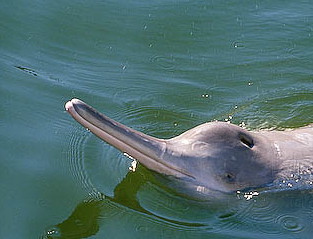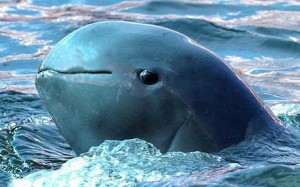River Dolphins are amongst the rarest aquatic mammals. They are found in big rivers of Asia and South America. The river dolphins can grow till 9-10 feet long and weigh almost 200 pounds. There are four different species of the river dolphins known to humans, out of which three are fresh water dolphins and the other one lives in saltwater estuaries. The fresh water species are: Ganges and Indus river dolphins (Sisu and Bhulan), Amazon river dolpins (Boto) and Chinese river dolphins (Baiji). La Plata Dolphin (Franciscana) is the only salt water river dolphin found in South America. All these four species are critically endangered. In fact, Baiji or Chinese river dolphins are declared functionally extinct in 2007. Here goes the stories of all the different species:
Ganges and Indus river dolphins:
Till 1998 Ganges and Indus river dolphins were considered as two different species. But in 1998 they were recognized as two sub species of the same species. These dolphins are found in India, Pakistan, Bangladesh, Nepal in Ganges, Brahmaputra and Indus rivers and their tributaries. The total estimated numbers of Ganges river dolphins is around 2000. Out of these, around 300 lives in Brahmaputra and are facing critical threat due to accidental killing through fisheries bycatch, followed by poaching for oil. Few decades ago the dophins were widely seen across Brahmaputra and almost all its tributaries. But now the dolphins survive only in small poackets of the river. The Indus rive dolphins also known as Blind river dolphins are found in the lower reaches of Indus river in Pakistan. Its believed that only 1000 of this species exist now in the Indus river.
Amazon river dolphins:
The Amazon river dolphins inhabit Orinoco, Amazon and Araguaia/Tocantins River systems of Brazil, Bolivia, Peru, Ecuador, Colombia and Venezuela. This species is the largest and the most intelligent of all river dolphin species. Although widely available in the Amazon, the number of this species is reducing every year. Scientists believe that 1,500 dolphins are being killed annually in the western Amazon to fuel a lucrative trade in catfish, which feeds on dead animals.
Chinese river dolphins:
A team of scientists have concluded that the Chinese River dolphin, or baiji, is now functionally extinct following comprehensive surveys of its habitat. Till 2006 it was found in Yangtze river of China. It is one more unfortunate event to animal history caused by human civilization. In last fifty years it is the only aquatic mammal extinction known to humans. Till 1950, around 6000 of this species existed in Yangtze river. But in few decades the number reduced due to hunting, pollution, habitat loss and other human interferences. The last Baiji was sighted in 2007.
La Plata river dolphins:
La Plata dolphins are the only river dolphins found in salt-water. They inhabitat in in coastal Atlantic waters of southeastern South America. They are greyish brown colour with the longest beak. The La Plata Dolphins grow 6 feet in length, weigh up to 50 kg (110 lb) and live for up to 20 years. The La Plata River Dolphin is well known because of where it chooses to build it’s habitat. It ranges through the La Plata River, which moves through Brazil and Argentina. Despite other fresh water dolphins, this particular dolphin has not adapted to only one type of water living. It can move back and forth from the salt waters of the ocean and to the river waters that are fresh. Scientists have raised concerns over the conservation of this species. Large numbers of them are hunted or killed every year.






Recent Comments